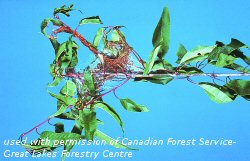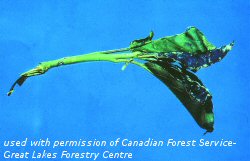Cherry Shoot Borer (Argyresthia Oreasella)


Webbed leaves Cherry Shoot Borer leaf damage
Host Plants And Distribution
This moth is a pest of chokecherry, saskatoon and hawthorn.
Biology
Adults are small silver-white moths with gold markings on the forewing. The adults are active from late May until August. Adult females lay their eggs on new shoots, likely in the fall, and the eggs overwinter. In spring, the eggs hatch and the larvae bore into the new shoots, causing them to wither, killing the flowers. Damage results in loss of the entire fruit cluster. Mature larvae are green in colour and reach a length of 7 mm. When larval development is complete, the larva emerges from the shoot, leaving a small exit hole at the base of the stem. Larvae change to pupae in late June to early July. Most information presented is with respect to saskatoon. Little is known about the life history of this insect on chokecherry thus far. The life cycle should be similar to that which occurs on saskatoon.
Symptoms And Damage
New shoots wither and die in late May and early June. Larvae create tiny holes at the base of the shoot when they bore in to begin feeding.
Scouting Techniques
New shoots should be monitored in the spring for signs of damage. In ornamental and recreational areas, the shoot borer can be controlled by clipping and destroying infested new shoots in late May. This type of control may not be feasible in orchard stands.
Economic Thresholds
No economic thresholds have been established for this pest.
